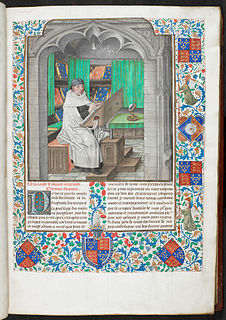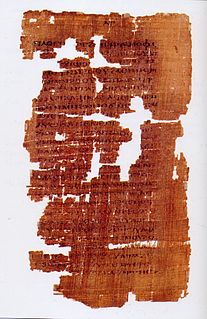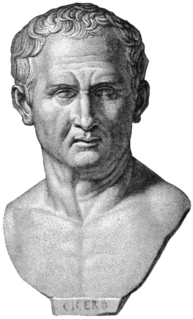Related Research Articles

Pseudo-Dionysius the Areopagite was a Greek author, Christian theologian and Neoplatonic philosopher of the late 5th to early 6th century, who wrote a set of works known as the Corpus Areopagiticum or Corpus Dionysiacum.
Pope Gelasius I was the bishop of Rome from 1 March 492 to his death on 19 November 496. Gelasius was a prolific author whose style placed him on the cusp between Late Antiquity and the Early Middle Ages. Some scholars have argued that his predecessor Felix III may have employed him to draft papal documents, although this is not certain.

Magnus Aurelius Cassiodorus Senator, commonly known as Cassiodorus, was a Roman statesman, renowned scholar of antiquity, and writer serving in the administration of Theodoric the Great, king of the Ostrogoths. Senator was part of his surname; not his rank. He also founded a monastery, Vivarium, where he spent the last years of his life.

De origine actibusque Getarum, commonly abbreviated Getica, written in Late Latin by Jordanes in or shortly after 551 AD, claims to be a summary of a voluminous account by Cassiodorus of the origin and history of the Gothic people, which is now lost. However, the extent to which Jordanes actually used the work of Cassiodorus is unknown. It is significant as the only remaining contemporaneous resource that gives an extended account of the origin and history of the Goths, although to what extent it should be considered history or origin mythology is a matter of dispute.

Scriptorium, literally "a place for writing", is commonly used to refer to a room in medieval European monasteries devoted to the writing, copying and illuminating of manuscripts commonly handled by monastic scribes.

The Pauline epistles, also known as Epistles of Paul or Letters of Paul, are the thirteen books of the New Testament attributed to Paul the Apostle, although the authorship of some is in dispute. Among these epistles are some of the earliest extant Christian documents. They provide an insight into the beliefs and controversies of early Christianity. As part of the canon of the New Testament, they are foundational texts for both Christian theology and ethics.
The Johannine Comma is an interpolated phrase (comma) in verses 5:7–8 of the First Epistle of John.
Pseudo-Isidore is the conventional name for the unknown Carolingian-era author behind an extensive corpus of influential forgeries. Pseudo-Isidore's main object was to provide accused bishops with an array of legal protections amounting to de facto immunity from trial and conviction; to secure episcopal autonomy within the diocese; and to defend the integrity of church property. The forgeries accomplished this goal, in part, by aiming to expand the legal jurisdiction of the Bishop of Rome.

The Codex Amiatinus is considered the best-preserved manuscript of the Latin Vulgate version of the Christian Bible. It was produced around 700 in the north-east of England, at the Benedictine monastery of Monkwearmouth–Jarrow in the Anglo-Saxon Kingdom of Northumbria, now South Tyneside and taken to Italy as a gift for Pope Gregory II in 716. It was one of three giant single-volume Bibles then made at Monkwearmouth–Jarrow, and is the earliest complete one-volume Latin Bible to survive, only the León palimpsest being older; and the oldest Bible where all the Books of the Bible present what would be their Vulgate texts.
Aurelian of Réôme was a Frankish writer and music theorist. He is the author of the Musica disciplina, the earliest extant treatise on music from medieval Europe.
Aethicus Ister was the protagonist of the 7th/8th-century Cosmographia, purportedly written a man of church Hieronymus, who purportedly censors an even older work for producing the book as its censored version. It is a forgery from the Middle Ages.

The Gospel of Pseudo-Matthew is a part of the New Testament apocrypha. In antiquity the text was called The Book About the Origin of the Blessed Mary and the Childhood of the Savior. Pseudo-Matthew is one of a genre of "Infancy gospels" that seek to fill out the details of the life of Jesus of Nazareth up to the age of 12, which are briefly given in the Gospels of Matthew and Luke. In the West, it was the dominant source for pictorial cycles of the Life of Mary, especially before the Late Middle Ages.

The Correspondence ofPaul and Seneca, also known as the Letters of Paul and Seneca or Epistle to Seneca the Younger, is a collection of letters claiming to be between Paul the Apostle and Seneca the Younger. There are 8 epistles from Seneca, and 6 replies from Paul. They were purportedly authored from 58–64 CE during the reign of Roman Emperor Nero, but appear to have actually been written in the middle of the fourth century. Until the Renaissance, the epistles were seen as genuine, but scholars began to critically examine them in the 15th century, and today they are held to be forgeries.

The Diocese of Pannonia, from 395 known as the Diocese of Illyricum, was a diocese of the Late Roman Empire. The seat of the vicarius was Sirmium.
Ars dictaminis refers to the art of letter-writing. The art of letter-writing often intersects with the art of rhetoric.
Christian views on the classics have varied throughout history. In the early years of Christianity, the writings of Classical and Hellenistic authors were widely spread by Christian teachers. However, during the Dark Ages, the decline in the study of this literature as a whole, as well as the waning of Christianity's popularity throughout Europe, resulted in the extinction of its effect in Christian life until the spread of Islam—the reintroduction of Classical texts—and the "rebirth" of Ancient Greek and Roman philosophies and arts during the Renaissance, where "artists and philosophers, each in their own way, combined Christian belief and ancient philosophy into a balanced, rational, humanistic system". Today, churches' views are generally consistent with those of Renaissance humanists' in that "Christians should be able to read the classics ... because it is part of the Western heritage ... [and] because it is part of Christianity’s inheritance."
The Greek Apocalypse of Daniel is a Christian pseudepigraphic text attributed to the Biblical Daniel and so associated with the Hebrew Bible. However, no Jewish or Christian groups regard this text as canonical or indeed as authoritative scripture. The canonical Book of Daniel has much apocalyptic imagery, and this apocalyptic-style text deals with a similar subject, describing one particular vision of Daniel regarding the appearance and activities of the Antichrist before the Day of Judgement.

Consolatio is a lost philosophical work written by Marcus Tullius Cicero in the year 45 BC. The work had been written to soothe his grief after the death of his daughter, Tullia, which had occurred in February of the same year. Not much is known about the work, although it seems to have been inspired by the Greek philosopher Crantor's ancient work De Luctu, and its structure was probably similar to a series of letter correspondences between Servius Sulpicius Rufus and Cicero.

The blood moon prophecies were a series of prophecies by Christian preachers John Hagee and Mark Biltz, related to a series of four full moons in 2014 and 2015. The prophecies stated that a tetrad which began with the April 2014 lunar eclipse was the beginning of the end times as described in the Bible in the Book of Joel, Acts 2:20, and Revelation 6:12. The tetrad ended with the lunar eclipse on September 27–28, 2015.
The Onomastics of the Gothic language are an important source not only for the history of the Goths themselves, but for Germanic onomastics in general and the linguistic and cultural history of the Germanic Heroic Age of c. the 3rd to 6th centuries. Gothic names can be found in Roman records as far back as the 4th century AD. After the Muslim invasion of Hispania and the fall of the Visigothic kingdom in the early 8th century, the Gothic tradition was largely interrupted, although Gothic or pseudo-Gothic names continued to be given in the Kingdom of Asturias in the 9th and 10th centuries.
References
- ↑ Jeremy Schipper Disability Studies and the Hebrew Bible 2006 - Page 50 "(Pseudo-Jerome, possibly an early ninth-century CE converted Jew, makes the same claim and states that David forgot his friendship and covenant with Jonathan).50 Likewise, b. Sabb. 56b mentions the heavenly voice's proclamation ..."
- ↑ Henry Ashworth (O.S.B.); Pseudo Jerome; Senator Cassiodorus (1963). The Psalter Collects: Of Pseudo Jerome, And, Cassiodorus. Manchester University Press. Retrieved 13 November 2012.